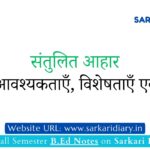Sarva Shiksha Abhiyan is an important government flagship scheme that aims to universalize elementary education. It aims to provide free and compulsory education to all children in the age group 6-14 years in a time-bound manner.

What is Sarva Shiksha Abhiyan?
Sarva Shiksha Abhiyan (SSA) is a government scheme that aims to universalize elementary education in a time-bound manner. It was started in 2001 under the Prime Minister ship of Atal Behari Vajpayee.
- Initially, its aim was to educate all the children of the age group 6-14 yrs by 2010. However, this timeline was later on extended indefinitely.
- SSA was also provided by the 86th constitutional amendment, where the provision of free and compulsory education was made for children belonging to the age group of 6-14 years.
- A new fundamental right, i.e., Right to Education, was made under Article 21A of the Indian Constitution.
Aims of SSA
The aims of SSA include:
- To provide free education for all children in the age group of 6-14 years.
- Remove the social and regional disparity by ensuring the active participation of the community in the management of the school.
- Inculcate value-based learning among the children. This will, in turn allow children to work for each other rather than selfish pursuit.
- To look upon the 0-14 age as a continuum and realize the importance of Early childhood care.
- Provide children with an opportunity to master their natural environment developing their potential both spiritually and materially.
Main objectives of Sarva Shiksha Abhiyan
The core objectives of Sarva Shiksha Abhiyan (SSA) are as follows:
- Enhancing Infrastructure: Improve existing school facilities such as classrooms, washrooms, and drinking water provisions.
- Expansion of School Network: Establish new schools in areas lacking educational facilities.
- Empowering Girls: Promote girls’ education to elevate their societal status and ensure gender equality.
- Inclusive Education: Make education accessible to children with special needs, ensuring no one is left behind.
- Digital Literacy: Bridge the digital divide by providing necessary computer education to students.
- Teacher Development: Strengthen teacher capacity through extensive training and the provision of learning aids.
- Academic Support: Develop and reinforce academic support structures at cluster, block, and district levels.
- Alternative Education: Offer alternative schooling options to cater to diverse learning needs.
- Access to Resources: Provide free uniforms and textbooks to students to ensure equal access to education.
- Teacher Recruitment: Increase teacher numbers where shortages exist, ensuring adequate staffing in schools.
- Life Skills Education: Equip students with essential life skills alongside quality education to prepare them for the challenges of the future.
These objectives collectively form the backbone of SSA, working towards the overarching goal of universalizing elementary education and fostering a more inclusive and equitable educational landscape.
Functions of Sarva Shiksha Abhiyan
The main functions of Sarva Shiksha Abhiyan include:
- Ensuring social justice by providing basic education to the children.
- To respond to the demand for improving the standards of education.
- To make the environment conducive and accessible for attaining basic education.
- To increase the literacy level of India by universalizing elementary education.
- Capacity building among the teachers by imparting them new intensive training and keeping them up to date with the latest teaching materials and teaching aids.
Beneficiaries of Sarva Shiksha Abhiyan
- Children of the age group of 06-14 years where will be imparted free education along with free uniforms and textbooks.
- Upgradation of existing infrastructure in schools by way of instituting regular grants to them.
- Teachers will be provided necessary to enhance pedagogy.
Achievement of Sarva Shiksha Abhiyan
- There is considerable improvement in the total enrolment in elementary schools from 18.79 crores in 2009-10 to 19.67 crores in 2015-16.
- PTR (Pupil teacher Ratio) has improved to 25 in 2015-16 from 32 in 2009-10.
- As per UDISE- GER(Gross Enrolment Ratio) is 99.21% for the primary level and 92.81% for the upper primary level.
- Out of School students shows a consistent drop from 134.6 lakh in 2005 to 81 lakh in 2009 and 60.64 lakh in 2015.
- The Gender Parity Index (GPI) has reached 0.93 for the primary and 0.95 for the upper primary level.
Limitations of Sarva Shiksha Abhiyan
- Despite the noble intentions of Sarva Shiksha Abhiyan (SSA) and its provision of free education, textbooks, and uniforms, significant challenges persist, particularly in remote regions of India:
- Parental Reluctance: Despite the availability of free education, some parents, especially in remote areas, remain hesitant to send their children to school. This reluctance may stem from various factors, including socio-economic constraints and cultural beliefs.
- Financial Barriers: While education itself may be free, additional expenses such as transportation and school supplies pose a burden for families, particularly those from economically disadvantaged backgrounds. These auxiliary costs often deter parents from enrolling their children in school.
- Learning Outcomes: Reports such as ASER by NGO Pratham highlight concerning disparities in learning outcomes, with a significant portion of students struggling to attain basic literacy levels. This underscores the need for enhanced quality and effectiveness in educational delivery.
- Teacher Shortages: The critical shortage of nearly 6,89,000 teachers hampers efforts to maintain the desired pupil-teacher ratio outlined in the Right to Education (RTE) norms. This deficit adversely affects the quality of education and individual attention received by students.
- Accountability Issues: Weak accountability mechanisms within SSA contribute to low attendance rates and subpar learning outcomes. Without robust monitoring and evaluation systems, it becomes challenging to ensure that resources are utilized effectively and that students receive the education they deserve.
- High Dropout Rates: Despite efforts to improve retention, a significant number of students still drop out of school, particularly between the ages of 6 and 11. This persistent issue underscores the need for targeted interventions to address the root causes of dropout and ensure continuous enrollment and engagement in education.
[catlist name=bed-deled]
Sarva Shiksha Abhiyan and District Primary Education Programme (DPEP)
- DPEP was a centrally-sponsored scheme that was launched in 1994 to revitalize the education system at the primary level.
- In this, 85% of the project cost is borne by the Central govt and the rest 15% by the state government.
- DPEP was the first program to achieve universalization in elementary education.
- In DPEP district was treated as a unit for planning and extended to 18 states.
- The central govt was assisted externally by international organizations like World Bank, UNICEF, etc.
Sarva Shiksha Abhiyan – Universalization of Elementary Education
The various Constitutional, national, and legal policies and statements that backed the cause of UEE are:
- Constitutional mandate: The state shall endeavor to provide free and compulsory education for all children till they complete 14 years of age under the Right to Education. It was made Fundamental Right by the 86th Constitutional Amendment Act,2002.
- National Policy of Education,1986: This policy too aimed at quality education for children up to the age of 14 years, along with their retention in school.
- Supreme Court: It also upheld the right of every child in the country to have free education till he/she attains 14 years of age in the Unnikrishnan Case,1993.
Conclusion of Sarva Shiksha Abhiyan
Sarva Shiksha Abhiyan is an initiative to achieve Universal Elementary education. This program is an attempt to upgrade human capabilities by providing community-owned quality education in a mission mode.
Recent initiatives under Sarva Shiksha Abhiyan
Here are some of the recent initiatives under Sarva Shiksha Abhiyan:
Padhe Bharat Badhe Bharat
This program was launched in 2014 to improve the reading and writing skills of Class I and Class II children. It aims to help the children understand the joys of reading and writing from a real-life perspective.
Samagra Shiksha
This program was launched in 2018 to consolidate the various education schemes under the Sarva Shiksha Abhiyan. It aims to provide holistic education to children from early childhood to secondary level.
Digital Shiksha
This program was launched in 2020 to provide digital learning solutions to children. It provides access to online courses, e-books, and other digital resources.







